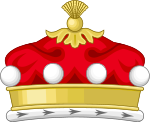| Barony Ashton of Hyde | |
|---|---|
  Sable on a pile between two crescents in base argent a mullet pierced of the first | |
| Creation date | 28 June 1911 [1] |
| Created by | King George V |
| Peerage | Peerage of the United Kingdom |
| First holder | Thomas Gair Ashton |
| Present holder | Henry Ashton, 4th Baron |
| Heir presumptive | Thomas Henry Ashton |
| Remainder to | 1st Baron's heirs male of the body lawfully begotten. [2] |
| Motto | Fide et virtute ("With faith and valour") [1] |
Baron Ashton of Hyde, of Hyde in the County of Chester, is a title in the Peerage of the United Kingdom. It was created on 28 June 1911 for the industrialist and Liberal politician Thomas Ashton. He had earlier represented Hyde and Luton in the House of Commons. [1]
Contents
Since 2008, the title has been held by his great-grandson, the fourth Baron, [3] who won a by-election to the House of Lords in July 2011 taking the Earl of Onslow's room. Ashton was appointed Chief Whip and Captain of the Honourable Corps of Gentlemen-at-Arms in July 2019.
